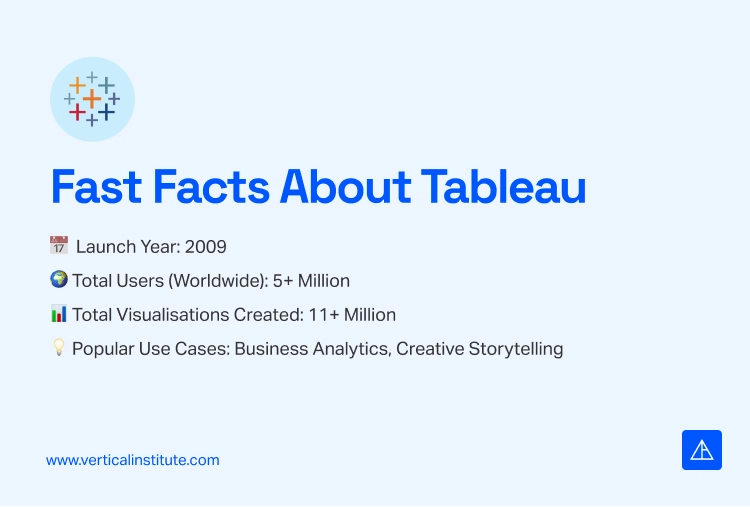Data visualisation plays a vital role in simplifying complex information. By presenting raw data as charts, graphs, and dashboards, it transforms numbers into a visual story that is easier to interpret. This helps professionals uncover trends, make well-informed decisions, and share insights more effectively.
Tableau is one of the most widely used data visualisation tools available today. Its primary function is to turn raw data into clear, interactive visuals that encourage data-driven decisions. As highlighted on Tableau’s official website, the platform is designed to make data analysis accessible to everyone, whether they’re beginners or experienced professionals.
Since Tableau Public’s launch in 2009, it has grown exponentially. With over 5 million users worldwide and more than 11 million visualisations created, the platform showcases its appeal for creating diverse, impactful content. These visualisations span topics from business analytics to creative storytelling, underlining Tableau’s adaptability and ease of use.

Building on insights from our previous blog posts on Tableau, we’ll consolidate the key information you need to understand Tableau, its standout features, benefits, and practical applications. Whether you’re encountering Tableau for the first time or refreshing your knowledge, this article will equip you with the essentials to get started.
Related Article: Power BI vs Tableau: What is the Best Data Visualisation Tool to Learn
Getting Started with Tableau for Data Visualisation
Tableau is a leading data visualisation software that helps users create interactive dashboards and visualisations. It is designed for everyone, regardless of their level of technical expertise. Tableau simplifies the process of analysing and presenting data, enabling users to derive actionable insights.
According to Tableau, the platform supports a variety of data sources, including spreadsheets, cloud-based databases, and more. Its drag-and-drop interface makes it beginner-friendly while providing powerful features for experienced professionals.
For those looking to explore data visualisation at no cost, Tableau Public is a free version of the software. Tableau Public allows users to create, publish, and share visualisations online, making it ideal for learners, educators, and anyone looking to showcase their work publicly.
Why Data Visualisation Matters to Analysts
Data visualisation is particularly valuable for analysts who must present data in clear and actionable ways. Visualisation tools bridge the gap between technical data analysis and practical business applications.
Data Visualisation in Action
- Analysts use data visualisation to track sales performance and identify emerging market trends effectively.
- Visualisation helps monitor customer behaviour, providing valuable insights for targeted marketing strategies.
- It also plays a key role in analysing operational efficiency, enabling organisations to optimise processes across various business functions.
Related Article: 7 Data Visualisation and Analytics Trends for Smarter Decisions in 2025
Data Visualisation: Key Benefits at a Glance
| Benefit | Description |
| 📉 Simplify Complexity | Break down large datasets into easy-to-understand visuals. |
| 🔍 Spot Trends and Anomalies | Detect patterns and outliers quickly and accurately. |
| 📊 Streamline Reporting | Present findings clearly for better stakeholder alignment. |
| 🧠 Support Decision-Making | Provide data-driven visuals for confident strategic choices. |
| 🌟 Enhance Collaboration | Share insights visually to encourage team input and cooperation. |
| 📚 Boost Data Storytelling | Create engaging narratives that make data impactful and actionable. |
What are the Key Features of Tableau?
Tableau offers a range of features that cater to users at all levels:
Drag-and-Drop Functionality
This feature makes it simple to create visualisations without coding, making it accessible for beginners.
Interactive Dashboards
Users can interact with their data through these dashboards, exploring and drilling into details for deeper insights.
Connectivity
Tableau supports integration with various data sources, such as Excel, SQL databases, and cloud platforms, enabling seamless data access.
Real-Time Collaboration
Teams can easily share dashboards and insights, promoting department collaboration and alignment.
Advanced Analytics
For advanced users, Tableau provides tools and options for more sophisticated and complex data analysis.
Related: 5 Study Strategies That Will Help You Ace the Tableau Certification
How Tableau Drives Impact Across Industries
Tableau is widely used across industries to solve specific challenges and provide actionable insights:
Sales
Businesses use Tableau to track sales performance across regions and product categories, identify trends in customer purchasing behaviour, and uncover areas for revenue growth.
Marketing
Marketing teams leverage Tableau to analyse campaign performance, measure customer engagement, and optimise their strategies by visualising conversion rates, ad spending, and audience data.
Finance
Financial professionals rely on Tableau to monitor critical metrics such as expenses, revenue, profit margins, and forecast future financial performance through detailed dashboards.
Healthcare
In the healthcare sector, Tableau helps organisations visualise patient data to improve outcomes, monitor operational efficiency, and identify areas for process improvement in hospital management.
Education
Educational institutions use Tableau to interpret student performance data, improve curriculum planning, and gain insights into enrolment trends and academic outcomes.
Why Learning Data Analytics Complements Tableau Skills
To fully harness the power of Tableau, it’s important to pair it with a solid foundation in data analytics. Combining analytical techniques with Tableau’s capabilities can unlock deeper insights and create more impactful visualisations.
- Maximise Tableau’s Potential
While Tableau excels at creating visualisations, understanding data analytics enhances your ability to clean, structure, and interpret data effectively before visualising it.
- Enhance Dashboard Accuracy
Knowledge of data preparation ensures that your Tableau dashboards are both accurate and meaningful.
- Apply Advanced Analytics
Skills like trend analysis, segmentation, and forecasting provide deeper insights, elevating the value of your visualisations.
To build these skills, Vertical Institute offers Data Analytics and Advanced Data Analytics courses that cover Tableau, along with essential tools like SQL and Excel. Designed to be completed in just 21 hours, the course provides hands-on experience and practical applications to equip learners with the knowledge they need to excel in data-driven roles.
Related Article: Why Learn Tableau? 4 Key Reasons to Elevate Your Data Analytics Skills
Data Analytics Course
Turn data to practical insights Using SQL, Excel & Tableau.
Conclusion
Tableau is more than just a tool as it bridges the gap between raw data and impactful insights. For those starting their careers, learning Tableau builds a valuable skill that enhances their ability to analyse and present data effectively. For experienced professionals, it provides a way to refine decision-making processes and communicate strategies.
This powerful tool allows you to uncover trends, tell meaningful stories, and make confident data-driven decisions. By mastering Tableau, you can redefine how you work with data and position yourself for success in today’s competitive, data-focused world.
Calculate Your Subsidy for the Data Analytics Course
Prepare for your enrolment in Vertical Institute’s Data Analytics courses by calculating your subsidy. Use SkillsFuture Credits and UTAP to reduce course costs. Take the first step toward investing in your future today.
COURSE SUBSIDY CALCULATOR
Discover how much you can save on Vertical Institute’s courses.
About Vertical Institute
Vertical Institute is shaping the future of work by preparing individuals for tomorrow’s job market. Our courses and certification focus on teaching essential skills and nurturing the next generation of innovators and leaders.
As an Approved Training provider (ATO) accredited by SkillsFuture Singapore (SSG) and the Institute of Banking & Finance Singapore (IBF), our courses adhere to the highest standards. They are government-subsidised and eligible for SkillsFuture Credits or NTUC UTAP Funding.



